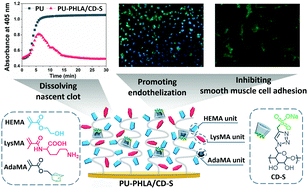A multifunctional surface for blood contact with fibrinolytic activity, ability to promote endothelial cell adhesion and inhibit smooth muscle cell adhesion†
Abstract
Blood compatible materials are required for a wide variety of medical devices. Despite many years of intensive effort, however, the blood compatibility problem, in particular the ability to prevent thrombosis, remains unsolved. Based on the knowledge that the vascular endothelium, the ultimate blood contacting surface, draws on several mechanisms to maintain blood fluidity, it seems reasonable that analogous multifunctionality should be the goal for blood compatible biomaterials. In the present work, a polyurethane surface was modified with the terpolymer poly(2-hydroxyethyl methacrylate-co-6-amino-2-(2-methacylamido)-hexanoic acid-co-1-adamantan-1-ylmethyl methacrylate) (poly(HEMA-co-LysMA-co-AdaMA)), referred to as PU-PHLA. Poly(HEMA) and poly(LysMA) were intended to provide, respectively, resistance to non-specific protein adsorption and the ability to lyse incipient clots. The heparin-like moiety, sulfonated β-cyclodextrin was immobilized on the PU-PHLA via host–guest interactions with the poly(AdaMA). This component is expected to inhibit coagulation and smooth muscle cell proliferation and to promote endothelialization. The resulting materials were shown to have multifunctionalities including fibrinolytic activity, anticoagulant activity and the ability to promote endothelial cell adhesion and inhibit smooth muscle cell adhesion. This work provides a new strategy for the development of multifunctional, endothelial-mimicking, biomaterials for blood contacting applications.

- This article is part of the themed collection: Celebrating Excellence in Research: Women of Materials Science


 Please wait while we load your content...
Please wait while we load your content...